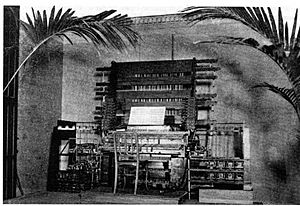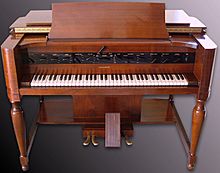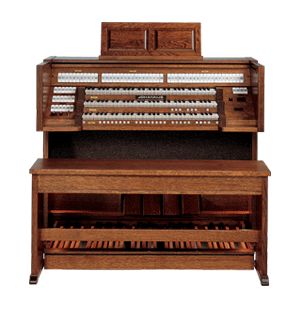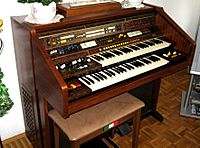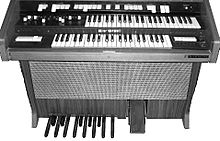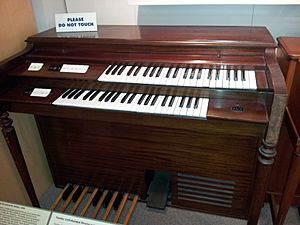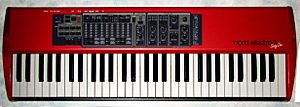Electronic organ facts for kids
An electronic organ is a special keyboard instrument that makes sounds using electricity. It's like a piano but can create many different sounds, often trying to sound like a big pipe organ or other instruments.
Today, there are two main types of electronic organs:
- Some electronic organs, called digital organs, are made to look and sound like traditional pipe organs. They are often used in churches and other large buildings. They are easier to move, stay in tune, take up less space, and cost less than real pipe organs. They also have cool computer features. However, some people feel they don't sound or feel quite the same as a real pipe organ.
- The other type is more common in homes. It's based on the Hammond organ and is popular for jazz and pop music. These organs often have many sound generators that can copy hundreds of different instruments.
Contents
- History of Electronic Organs
- Early Ideas
- First Electric Organs (1897–1930s)
- Electrostatic Reed Organs (1934–1964)
- Electronic Organs Become Popular (1930s–)
- Frequency Divider Organs (1930s–)
- Console Organs (1930s–)
- Home Organs (1940s–)
- Spinet Organs (1949–)
- Chord Organs (1950–)
- Transistor Organs (1957–)
- Combo Organs (1950s–)
- Digital Organs (1971–)
- Modern Digital Organs (1980s–)
- Software Organs (1990s–)
- Electronic Organs in Churches
- Other pages
- Images for kids
History of Electronic Organs
Early Ideas
Before electronic organs, people used instruments that worked in similar ways.
The Harmonium
The harmonium, or reed organ, was very popular in homes and small churches in the late 1800s and early 1900s. It made sound by pushing air over reeds using foot pedals, a bit like a pipe organ. Harmoniums were small, cheap, and didn't need outside power. They brought an organ-like sound to places that couldn't fit or afford a large pipe organ. This idea of a smaller, more accessible organ was important for electronic organs later on.
Pipe Organ Influence
In the 1930s, some companies started making electronic organs that tried to copy the sound and function of pipe organs. They thought this was the best way to develop new electronic organs. But not everyone agreed, and many different types of electronic organs have been created since then.
First Electric Organs (1897–1930s)
Electricity started to be used with organs in the early 1900s, but it took a while to make a big impact. Early electric reed organs sounded much like the older foot-pumped ones.
A huge and unusual instrument called the Telharmonium was invented by Thaddeus Cahill in 1897. It sent music to places in New York City through telephone lines! The Telharmonium was the first instrument to show how combining many different electrical sounds could create real instrument sounds. Cahill's ideas were later used by Laurens Hammond in his famous organ designs. The Telharmonium weighed 200 tons and was the world's first large-scale electric music machine.
Electrostatic Reed Organs (1934–1964)
After Hammond invented his tonewheel organ in 1934, other companies looked for different ways to make electric organs. One idea was to create a purely electronic version of the pipe organ. However, this needed many oscillators (sound makers), and the early vacuum tube circuits were too big and unstable.
Benjamin Miessner came up with a clever idea: combine acoustic (sound-producing) parts with electronic circuits. This led to the Orgatron, first made in 1934. It used a fan to blow air over reeds, making them vibrate. These vibrations were then turned into electric signals, amplified, and sent out as musical tones. The Orgatron was made by Everett Piano Company and later by the Rudolph Wurlitzer Company.
Around the same time in Japan, a Yamaha engineer invented the Yamaha Magna Organ in 1935. It was similar to the Orgatron, using electrically blown reeds and pickups to create sounds.
Electronic Organs Become Popular (1930s–)
The Hammond Novachord (1939) and other organs used a different method to create sounds. They combined various oscillators and filters to reduce the number of sound makers needed. Early models used vacuum tubes, which made a lot of heat, earning them the nickname "toaster." Today's organs use solid-state parts, so they don't have this problem and don't need time to warm up.
Electronic organs became very popular home instruments, costing about the same as pianos. They were even sold in department stores. Their popularity grew after World War II, especially with performances by organists like Ethel Smith in movies. Sales peaked in the mid-1970s but then dropped as television and high fidelity audio systems became popular home entertainment. Home electronic organs usually tried to sound like theatre organs or Hammonds, rather than classical organs.
Frequency Divider Organs (1930s–)
Early electronic organs in the 1930s and 1940s used a technology called frequency division. This meant they used a few sound makers (oscillators) to create one octave of notes, and then used frequency dividers to create all the other notes.
When transistors were invented, electronic organs that didn't need mechanical parts became possible. The first of these were frequency divider organs. They were even cheaper and more portable than Hammond organs. Later, it became possible to run an organ from just one radio frequency oscillator. Many companies built these organs, and some were even sold as kits for hobbyists to build themselves. The Lowrey organ played by Garth Hudson is a famous example. Its electronic design allowed for a pitch bend feature, which wasn't available on Hammonds.
Console Organs (1930s–)
Console organs were large and expensive electronic organs that looked like pipe organ consoles. They had full-size keyboards, many different sounds (stops), and a two-octave (or even 32-note) pedalboard that could be played with both feet. These organs were sometimes called "concert organs."
Console organs had speakers built in, usually above the pedals. Because they were more traditional and capable than smaller organs, they were good for small churches, public performances, and even learning to play the organ. Students who learned on a console organ could easily switch to a pipe organ in a church. Many college music departments and church musicians had console organs for practice.
Home Organs (1940s–)
From the 1940s to the 1970s, many different electronic home organs were popular for home entertainment. These organs were often inspired by theatre organs and had sounds like "trumpet" and "marimba." As technology improved, they started to include automatic features like:
- One-touch chords (playing a whole chord with one key)
- Electronic rhythm
- Automatic walking bass
- Arpeggiator (playing notes of a chord one after another)
- Autochord
- Even built-in tape players
These features made it easier for people who weren't trained organists to play complete, layered "one-man band" arrangements. The Lowrey organ line is a great example of this type of instrument. While some are still sold today, their popularity has decreased, and many of their functions are now found in smaller, cheaper portable keyboards.
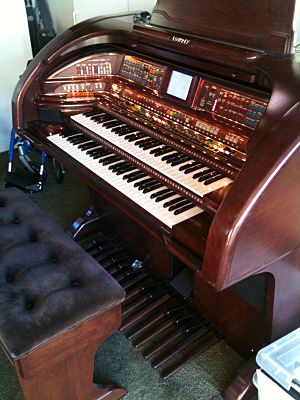
Spinet Organs (1949–)
After World War II, most electronic home organs were built as spinet organs, which first appeared in 1949. These small and relatively cheap instruments became the natural follow-up to reed organs. They were sold as competitors to home pianos and were often aimed at pianists who wanted to try the organ. The spinet organ looked like a piano and had simpler controls that were cheaper to make and easier to learn. One cool feature was automatic chord generation: you could play a whole chord by just pressing one key on a special part of the keyboard.
Spinet organs usually had shorter keyboards than normal organs. The top keyboard (upper manual) often left out the bass notes, and the bottom keyboard (lower manual) left out the high notes. The keyboards were usually offset, encouraging players to use their right hand on the top and left hand on the bottom. This helped pianists, who were used to one keyboard, to use both. The sounds (stops) on these organs were limited and often named after orchestral instruments they could only roughly copy. The speakers were built into the instrument, saving space, but the sound wasn't as good as separate speakers.
The spinet organ's pedalboard usually had only one octave of notes and could often play only one note at a time. It was mostly played with the left foot. These limits, along with the shorter keyboards, made spinet organs not very useful for classical organ music. However, they allowed new home organists to try playing with two hands and one foot at the same time. The expression pedal, which controls the volume, was placed so it was easy to reach with the right foot. This led to a style of playing where people would often keep their right foot on the pedal, pumping it to change the volume, much like using a piano's sustain pedal. This added a strong dynamic element to home organ music and influenced a new generation of popular keyboard artists.
Chord Organs (1950–)
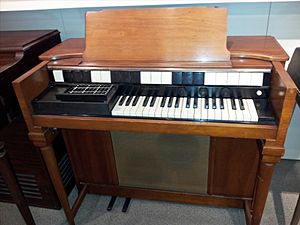
Soon after the spinet organ, the "chord organ" appeared. This was an even simpler instrument for people who wanted an organ sound without learning much organ or piano technique. A typical chord organ had only one keyboard, even shorter than a spinet's. It also had fewer sounds and no pedalboard. Instead of a left-hand keyboard, it had an array of chord buttons, like those on an accordion.
The first Hammond chord organs in 1950 used vacuum tubes. In 1958, Magnus Organ Corporation introduced chord organs that were similar to electrically blown reed organs.
Transistor Organs (1957–)
Before the mid-1950s, electronic organs used large and unstable vacuum tubes. This made it hard to add more features and sell them for homes. Transistors, invented in 1947, started being made in the 1950s. Their small size and stability caused a big change in electronics, known as the "transistor revolution."
In 1957, Gulbransen, a home organ maker, introduced the world's first transistor organ, the Model B. It used transistors for making sounds, but still had vacuum tubes for making the sound louder. In 1958, Rodgers built the first fully transistorized organ for churches, called Opus 1. Other companies soon followed.
Combo Organs (1950s–)
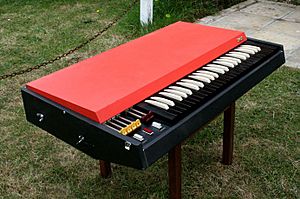
By the 1960s, electronic organs were everywhere in popular music, from Lawrence Welk to acid rock bands like The Doors. Sometimes, Hammonds were used. Other times, very small all-electronic instruments, only slightly bigger than modern digital keyboards, called combo organs were used. Portable organs by Farfisa and Vox were especially popular with rock bands.
The 1970s, 1980s, and 1990s saw more specialized instruments. Gospel and jazz still used Hammonds a lot. Meanwhile, different kinds of rock started using more complex electronic keyboards as digital technology became common.
Digital Organs (1971–)
Allen introduced the world's first digital organ in 1971. This new technology was first developed for home organs by North American Rockwell and then licensed to Allen for church organs.
An Eminent 310 organ was famously used on Jean Michel Jarre's albums Oxygène (1977) and Équinoxe (1978). The Solina String Ensemble was also used by many pop, rock, jazz, and disco artists.
In 1980, Rodgers introduced the first church organs controlled by microprocessors. This technology came from research at the University of Bradford. Today, some European digital organs still use similar sound-making technology.
This type of instrument also became popular with classically trained organists who didn't want to learn a new pipe organ for every concert. They also used them in places without pipe organs. Famous organists like Virgil Fox, Carlo Curley, Hector Olivera, and Cameron Carpenter have toured with large custom digital organs.
Modern Digital Organs (1980s–)
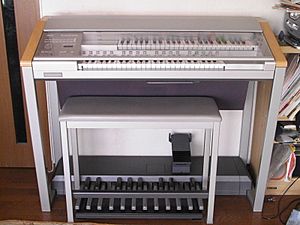
Electronic organs are still made for homes, but they have largely been replaced by smaller, cheaper, and more capable digital keyboards or synthesizers. Modern digital organs are much more advanced than older ones. Today's digital organs are very complex and can even offer features not found in pipe organs, like orchestral sounds, different historical pitch standards, and advanced playing aids.
Today's instruments use real-time sound generation (based on sampling or synthesis), MIDI (a way for instruments to talk to each other), and Internet connections for downloading music. They also use USB flash drives or media cards for storage. Even though they are very different inside, their basic look still shows they are the latest in a long line of electronic organs going back over eighty years.
The best digital organs today have special features that make their sound better than older, simpler instruments:
DSP Technology
In 1990, Rodgers introduced digital church organs that used software and special chips called Digital Signal Processors (DSPs). These chips worked together to create pipe organ sounds with stereo effects. Most current digital organs use DSPs to generate organ sounds, either by sampling or synthesis. Sampling uses recorded sounds from real pipe organs. Synthesis creates the sound waves without using a recorded sample. Both systems create organ tones, sometimes in stereo.
Sampling
Many digital organs today use high-quality samples to make the sound as accurate as possible. They might have samples of actual organ pipes for each note, or they might use a few samples and then change their pitch to create a full range of notes. Some digital organs use longer samples for even more realism. Sampling in modern organs is usually done with very high quality, better than CD-quality audio.
Surround Sound
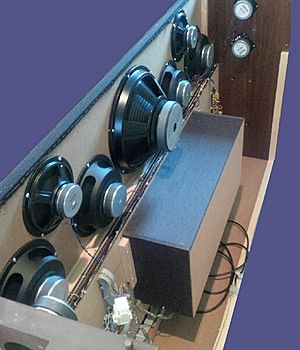
Most digital organs use several audio channels to create a more spacious sound. High-quality custom digital organ builders use special audio and speaker systems, sometimes with 8 to 32 or more separate audio channels. With powerful subwoofers for low sounds, the best digital organs can feel like a real pipe organ.
Pipe Organ Simulations
To sound even more like pipe organs, some digital organs copy changes in windchest pressure. In a pipe organ, the air pressure might drop slightly when many notes play at once, which changes the sound of the pipes. Digital organs can simulate this.
They can also copy other pipe organ features, like the sound of pipe chest valves opening and closing. These effects are added to the computer-generated sound to make it more realistic. Digital organs can also simulate the sound of a room's acoustics. Rodgers' "RSS" technology and Allen's "Acoustic Portrait" are examples of systems that include room acoustics in the sound generation.
Software Organs (1990s–)
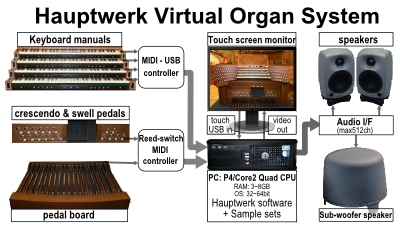 A software organ system |
Today's powerful personal computers have brought organs even closer to everyone. There are software programs that store digital pipe samples and play them in real time when you use a MIDI keyboard. Some popular programs include Hauptwerk, MyOrgan, GrandOrgue, and Miditzer (which copies a Wurlitzer theatre organ). Many hobbyists use these tools to build their own organs at home, which can sound as good as commercial digital organs but cost less.
Electronic Organs in Churches
Pipe/Electronic Hybrid Organs (1930s–)
Since the 1930s, some organs have combined electronic sound generators with real pipes. Sometimes, old pipe organ consoles are replaced with new electronic ones. This updates the control system for the pipes and adds electronic sounds to the organ. Today, even large pipe organs often use electronic sounds for very deep bass notes that would otherwise need huge 16- to 32-foot pipes.
A challenge with hybrid organs is that pipes change pitch with temperature and humidity, but electronic sounds don't. So, the electronic part of a hybrid organ must be tuned to match the pipes as needed. This can be done manually by the organist or automatically by some newer digital models.
Electronic Church Organs (1939–)
The first full electronic church organ was built in 1939 by Jerome Markowitz, who founded the Allen Organ Company. He worked for years to copy pipe organ sounds using circuits based on radio tubes. In 1958, Rodgers Organ Company built the first solid-state, transistorized church organ, its three-manual Opus 1.
Unlike simpler frequency divider organs, good electronic church organs have at least one sound maker (oscillator) for each note, and often more, to create a richer sound. For example, Rodgers Opus 1 had eight sets of transistorized sound generators. Even today, digital organs use software-based digital oscillators to create many independent sounds, making them sound more like a large pipe organ.
Digital Church Organs (1971–)
These instruments are designed to replace pipe organs or to be digital consoles that play existing pipes. They have improved a lot in the last twenty years and are now a common choice instead of pipe organs, especially in churches. The technology is so good that there are often only small differences in sound between pipe and digital organs, though some organists still argue that nothing beats a real pipe organ.
However, many churches that can't afford pipe organs choose less expensive electronic organs. A church might even choose a digital organ that sounds like a much larger pipe organ than they could ever afford or fit in their building.
Digital organs are also a good option for churches that had a pipe organ but can no longer afford to maintain it. Some people who prefer pipe organs say that digital organs are just like multi-note stereo systems and might not last as long as electronic equipment. Pipe organs, on the other hand, can last for centuries. But pipe organs are very expensive to build, so digital and hybrid organs now sell much more than pipe organs. Also, there are few pipe organ dealers, so many churches are far from someone who can sell, install, and fix a pipe organ. Electronic organs are simpler and cheaper, and a regular electrician can easily install them.
Most current digital church organs use recorded pipe sampling to make sounds. However, some, like Eminent, create the pipe sound using modeling. A professional organ "voicer" fine-tunes the organ in its location, similar to how a pipe organ is adjusted. These organs also use very high-quality custom sound systems. Companies that build custom and factory digital church organs include Ahlborn-Galanti, Allen, Eminent, Johannus, Makin, Rodgers, Viscount, and Wyvern.
Other pages
Images for kids
-
Yamaha Electone Stagea EL-900m (2000)


